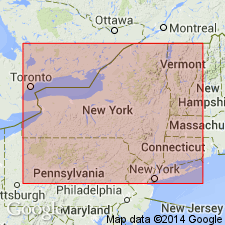
- Usage in publication:
-
- Lincoln Park submember
- Modifications:
-
- First used
- Dominant lithology:
-
- Shale
- AAPG geologic province:
-
- Appalachian basin
Summary:
Marcellus Formation will be "formally" raised to subgroup status within the Hamilton Group and be divided into a lower Union Springs Formation and an upper Mount Marion Formation (in eastern New York), and an upper Oatka Creek Formation (in central and western New York), in a publication by Ver Straeten and others (in prep). Union Springs Formation will incorporate three members across New York: the Bakoven Member (geographically extended across the State of New York), the Stony Hollow Member (restricted), and the Hurley Member (new). The Hurley underlies the Cherry Valley Member at the base of the laterally equivalent Mount Marion and Oatka Creek Formations. The Hurley is a distinctive unit found at all outcrops studied across New York and into central Pennsylvania. Composed of a richly fossiliferous limestone and overlying shale. Generally thin (30 to 60 cm) in western New York and Pennsylvania, but ranges to 7 m at its type section in eastern New York. The base is defined as the lowest carbonate-rich fossiliferous bed above a massive sandstone at the top of the Stony Hollow Member (revised) in eastern New York or black shales of the Bakoven Member (redefined) west of Albany. Two informal subdivisions will also be proposed: the Chestnut Street submember (lower, limestone) and the Lincoln Park submember (upper, shaly).
["Submember" not recognized as a formal stratigraphic rank term (CSN, 1933; ACSN, 1961, 1970; NACSN, 1983, 2005). Considered informal until formally published. The rank or lithologic term should not be capitalized.]
Source: Modified from GNU records (USGS DDS-6; Reston GNULEX).
For more information, please contact Nancy Stamm, Geologic Names Committee Secretary.
Asterisk (*) indicates published by U.S. Geological Survey authors.
"No current usage" (†) implies that a name has been abandoned or has fallen into disuse. Former usage and, if known, replacement name given in parentheses ( ).
Slash (/) indicates name conflicts with nomenclatural guidelines (CSN, 1933; ACSN, 1961, 1970; NACSN, 1983, 2005, 2021). May be explained within brackets ([ ]).

